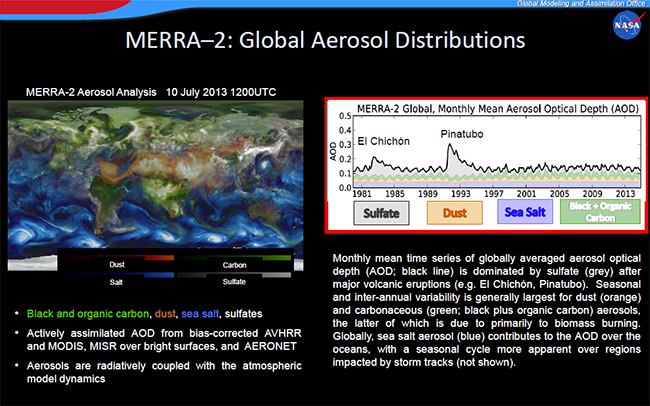MERRA-2 Global Aerosol Distributions
Atmospheric aerosols are small particles such as dust and soot that are suspended in the atmosphere for up to about a week. These particles are important to climate because they alter the Earth's radiative balance by scattering and absorbing solar and thermal radiation and by interacting with and changing cloud properties. Aerosols also contribute to poor air quality and reduced visibility. In addition to standard meteorological parameters (wind, temperature, moisture, surface pressure), MERRA-2 now includes an aerosol reanalysis using the Goddard Earth Observing System version 5 (GEOS-5) Goddard Aerosol Assimilation System (GAAS). Using the interactive Goddard Chemistry, Aerosol, Radiation, and Transport (GOCART) aerosol module, the GAAS includes 15 aerosol tracers (dust, sea-salt, sulfate, black and organic carbon) whose lifetime is driven by prescribed sea-surface temperature and sea-ice, daily volcanic and biomass burning emissions, as well as high-resolution inventories of anthropogenic emission sources. The GAAS includes assimilation of bias-correct aerosol optical depth (AOD) from several ground- and satellite-based sensors, including AVHRR, MODIS Aqua and Terra, MISR over bright surfaces, and AERONET. The MERRA-2 aerosol reanalysis produced by the Global Modeling and Assimilation Office (GMAO) thus provides observationally-constrained aerosol optical depth from 1980 – present, with aerosol speciation determined from GOCART model.
The figure on the left shows a snapshot of the AOD on July 10, 2013. Colors represent the four major aerosol types: dust (orange), sea salt, black and organic carbon (green) and sulfate (white). Sea salt aerosols are prominent over the oceans, particularly in the vicinity of storm tracks where stronger winds drive increased emissions. Dust aerosol is found over and downwind of barren, arid land regions, where high winds loosen soil particles and loft them into the atmosphere. Carbonaceous aerosol are prevalent especially in regions where there are large, seasonal fires like in southern Africa, South America and boreal forests of Canada and Siberia. Carbonaceous aerosols are also associated with human activities such as emitted by diesel vehicles or produced from biofuel burning and are thus also prevalent near large human populations, particularly in the developing world (e.g. India and China). Sulfate aerosols are associated with industrial pollution (sulfur dioxide gas), and are seen over the east coast of North America, Europe, and China; they are also produced when sulfur dioxide gas from volcanic eruptions converts to sulfate particles.
The figure on the right shows the time series of globally, annual average AOD from the aerosol reanalysis (black line) and the contributions from the different aerosol types. The AOD timeseries, and the sulfate aerosol contribution to the AOD, is dominated by the eruptions of two prominent volcanoes, El Chichón in Mexico (1982) and Pinatubo in the Philippines (15.1°N, 120.4°E) on 15 June 1991. The seasonal cycle in AOD fluctuates due to seasonal cycles in dust and biomass burning emissions. Importantly, while the aerosol assimilation constrains the total AOD (black line), the relative contributions of the different aerosol types are determined by the aerosol lifecycle simulated in the GEOS-5/GOCART model, which depends on the prescribed emissions and loss processes simulated by the model.


